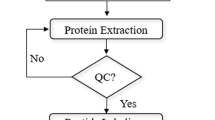Abstract
Endometrium attains a secretory architecture in preparation for embryo implantation, but the identity of most endometrial secretory products remains unknown. Our objective was to characterize the endometrial secretome and compare protein expression between prereceptive (luteinizing hormone [LH]+4) and receptive (LH+9) phase endometrium. Endometrial lavage was performed in 11 participants and analyzed by difference gel electrophoresis (DIGE). LH+4 and LH+9 specimens were labeled with cyanine fluorescent dyes Cy3 and Cy5 tags, respectively, and combined. Proteins were separated using 2-dimensional gel electrophoresis, isolated, trypsin-digested, and subjected to mass spectrometry. In all, 152 proteins were identified; 82 were differentially expressed. Most proteins with increased expression on LH+9 functioned in host defense, while proteins with decreased expression had many functions. A total of 14 proteins had changes suggesting altered posttranslational modification. This article describes the first application of proteomic analysis to endometrial secretions, allowing identification of novel endometrial proteins as well as those differentially secreted in prereceptive and receptive phases.
Similar content being viewed by others
References
Webb PD, Glasser SR. Implantation. In: Wolf DP, Quigley MM, eds. Human In Vitro Fertilization and Embryo Transfer. New York, NY: Plenum Press; 1984:341.
Levi Setti PE, Colombo GV, Savasi V, et al. Implantation failure in assisted reproductive technology and a critical approach to treatment. Ann N Y Acad Sci. 2004;1034:184–199.
Norwitz ER, Schust DJ, Fisher SJ. Implantation and survival of the early pregnancy. N Engl J Med. 2001;345(19): 1400–1408.
Noyes RW, Hertig AW, Rock J. Dating the endometrial biopsy. Fertil Steril. 1950;1:3–25.
Duggan MA, Brashert P, Ostor A, et al. The accuracy and interobserver reproducibility of endometrial dating. Pathology. 2001;33(3):292–297.
Murray MJ, Meyer WR, Zaino RJ, et al. A critical analysis of the accuracy, reproducibility, and clinical utility of histologic endometrial dating in fertile women. Fertil Steril. 2004;81(5):1333–1343.
Coutifaris C, Myers ER, Guzick DS, et al. Histological dating of timed endometrial biopsy tissue is not related to fertility status. Fertil Steril. 2004;82(5):1264–1272.
Myers ER, Silva S, Barnhart K, et al. Interobserver and intraobserver variability in the histological dating of the endometrium in fertile and infertile women. Fertil Steril. 2004;82(5):1278–1282.
Kyama CM, T’Jampens D, Mihalyi A, et al. ProteinChip technology is a useful method in the pathogenesis and diagnosis of endometriosis: a preliminary study. Fertil Steril. 2006;86(1):203–209.
DeSouza L, Diehl G, Yang EC, et al. Proteomic analysis of the proliferative and secretory phases of the human endometrium: Protein identification and differential protein expression. Proteomics. 2005;5(1):270–281.
Zhang H, Niu Y, Feng J, Guo H, Ye X, Cui H. Use of proteomic analysis of endometriosis to identify different protein expression in patients with endometriosis versus normal controls. Fertil Steril. 2006;86(2):274–282.
Seppala M, Koistinen H, Koistinen R, et al. Glycodelins as regulators of early events of reproduction. Clin Endocrinol (Oxf). 1997;46(4):381–386.
Cullinan EB, Abbondanzo SJ, Anderson PS, Pollard JW, Lessey BA, Stewart CL. Leukemia inhibitory factor (LIF) and LIF receptor expression in human endometrium suggests a potential autocrine/paracrine function in regulating embryo implantation. Proc Natl Acad Sci U S A. 1996;93(7): 3115–3220.
Johnson GA, Burghardt RC, Bazer FW, Spencer TE. Osteo-pontin: roles in implantation and placentation. Biol Reprod. 2003;69(5):1458–1471.
Savaris RF, Hamilton AE, Lessey BA, Guidice LC. Endome-trial gene expression in early pregnancy: lessons from human ectopic pregnancy. Reprod Sci. 2008;15(8):797–816.
Yang EC, Guo J, Diehl G, et al. Protein expression profiling of endometrial malignancies reveals a new tumor marker: cha-peronin 10. J Proteome Res. 2004;3(3):636–643.
Yoshizaki T, Enomoto T, Nakashima R, et al. Altered protein expression in endometrial carcinogenesis. Cancer Lett. 2005;226(2):101–106.
DeSouza LV, Grigull J, Ghanny S, et al. Endometrial carcinoma biomarker discovery and verification using differentially tagged clinical samples with multidimensional liquid chromatography and tandem mass spectrometry. Mol Cell Proteomics. 2007;6(7):1170–1182.
Zhang H, Niu Y, Feng J, Guo H, Ye X, Cui H. Use of proteomic analysis of endometriosis to identify different protein expression in patients with endometriosis versus normal controls. Fertil Steril. 2006;86(2):274–282.
Parmar T, Gadkar-Sable S, Savardekar L. Protein profiling of human endometrial tissues in the midsecretory and prolifera-tive phases of the menstrual cycle. Fertil Steril. 2008 Epub ahead of print.
Talbi S, Hamilton AE, Vo KC, et al. Molecular phenotyping of human endometrium distinguishes menstrual cycle phases and underlying biological processes in normo-ovulatory women. Endocrinology. 2006;147(3):1097–1121.
Kao LC, Tulac S, Lobo S, et al. Global gene profiling in human endometrium during the window of implantation. Endocrinology. 2002;143(6):2119–2138.
Mirkin S, Arslan M, Churikov D, et al. In search of candidate genes critically expressed in the human endometrium during the window of implantation. Hum Reprod. 2005;20(8): 2104–2117.
Author information
Authors and Affiliations
Corresponding author
Additional information
The study was conducted at the University of North Carolina at Chapel Hill.
Rights and permissions
About this article
Cite this article
Scotchie, J.G., Fritz, M.A., Mocanu, M. et al. Proteomic Analysis of the Luteal Endometrial Secretome. Reprod. Sci. 16, 883–893 (2009). https://doi.org/10.1177/1933719109337165
Published:
Issue Date:
DOI: https://doi.org/10.1177/1933719109337165




